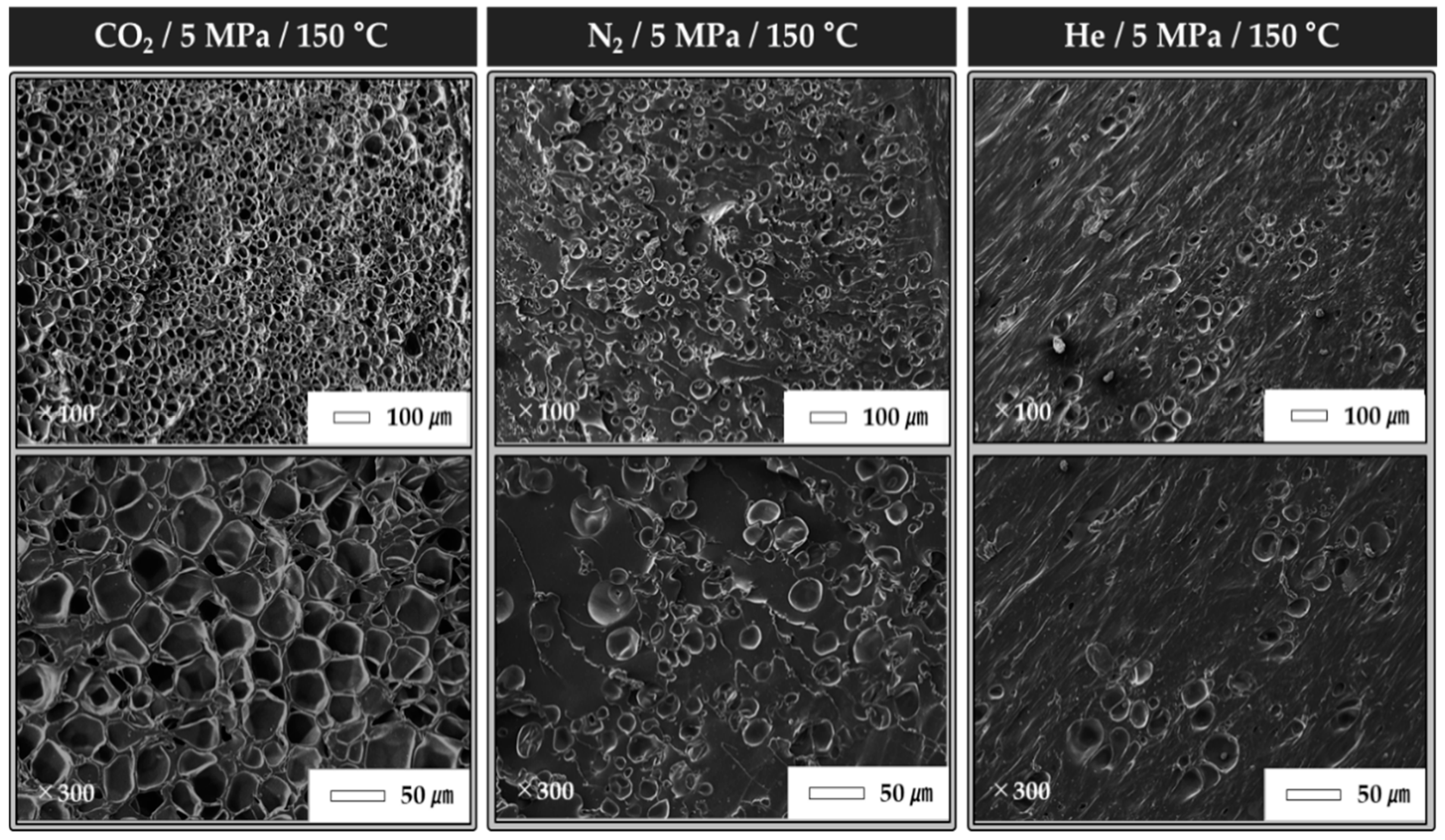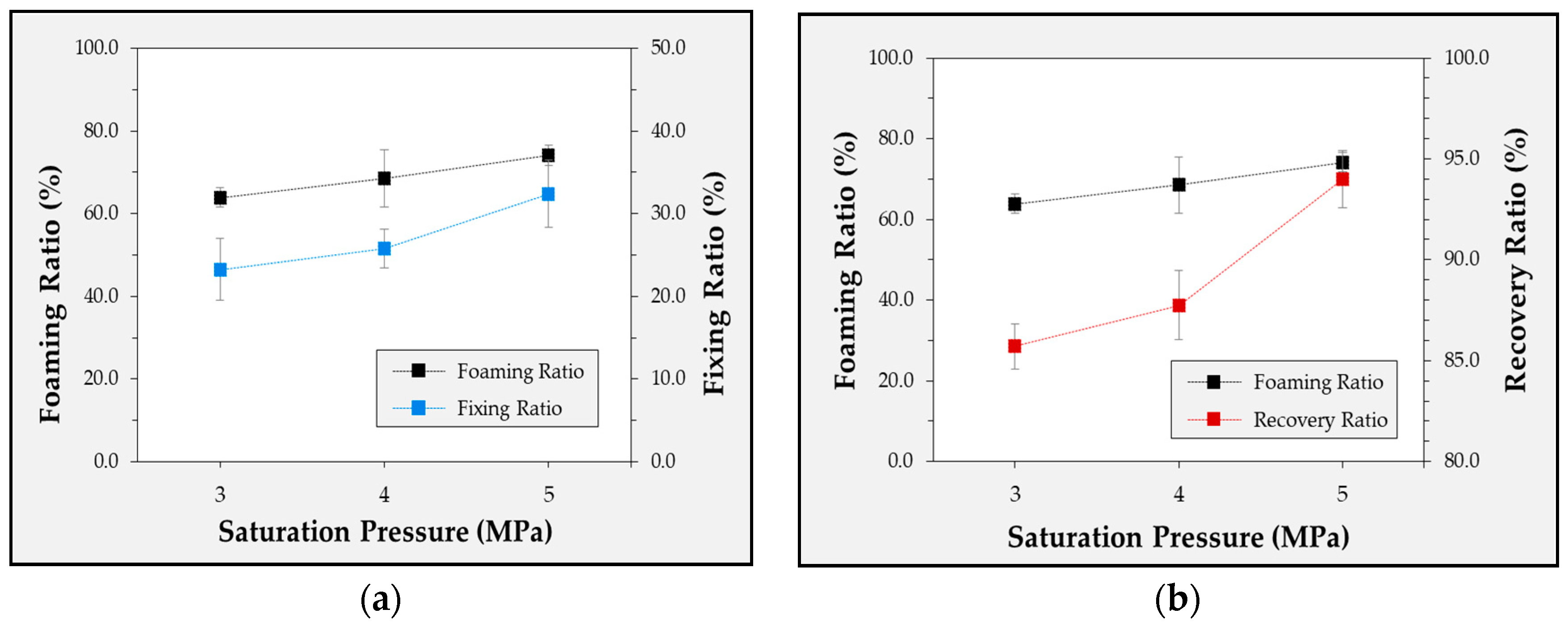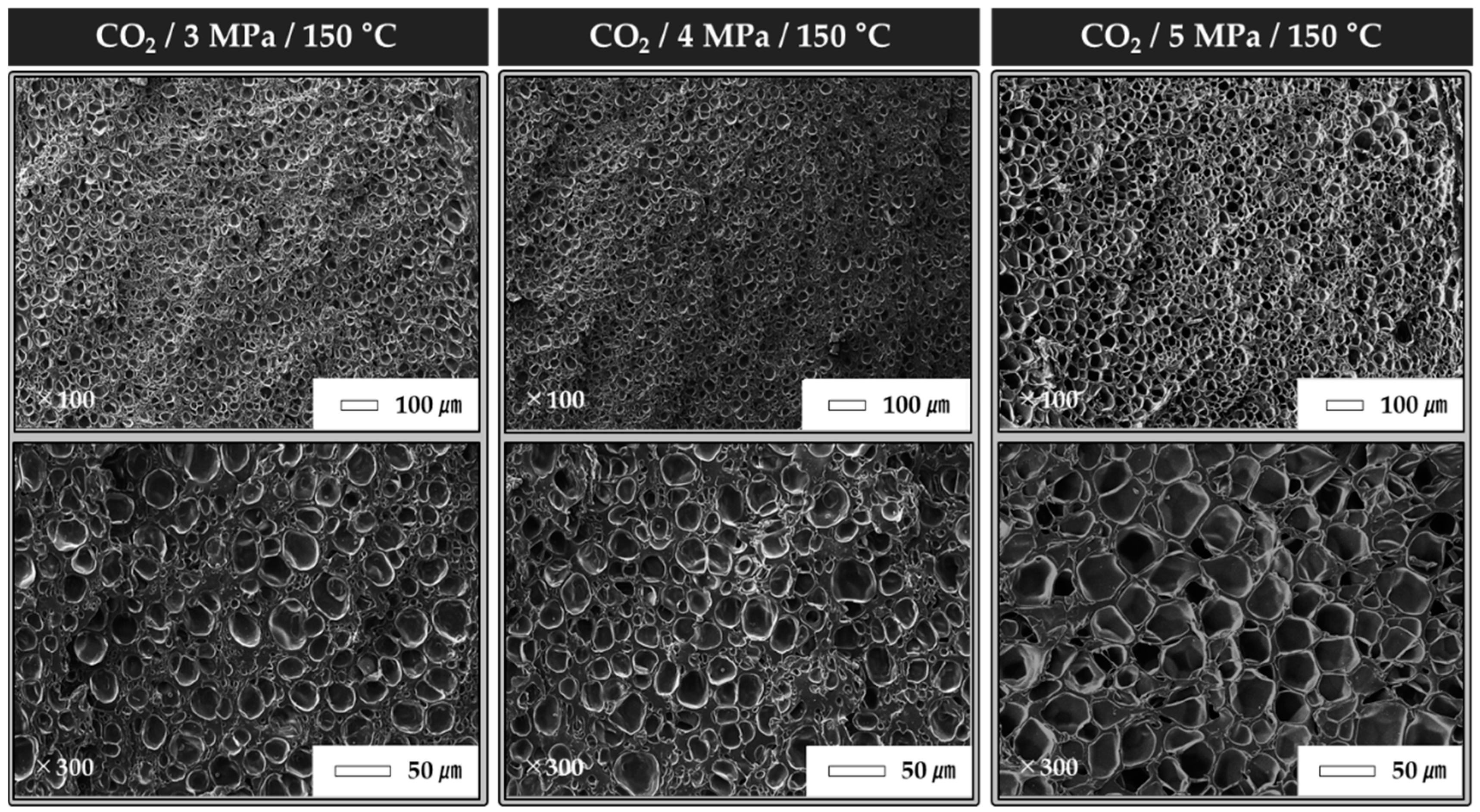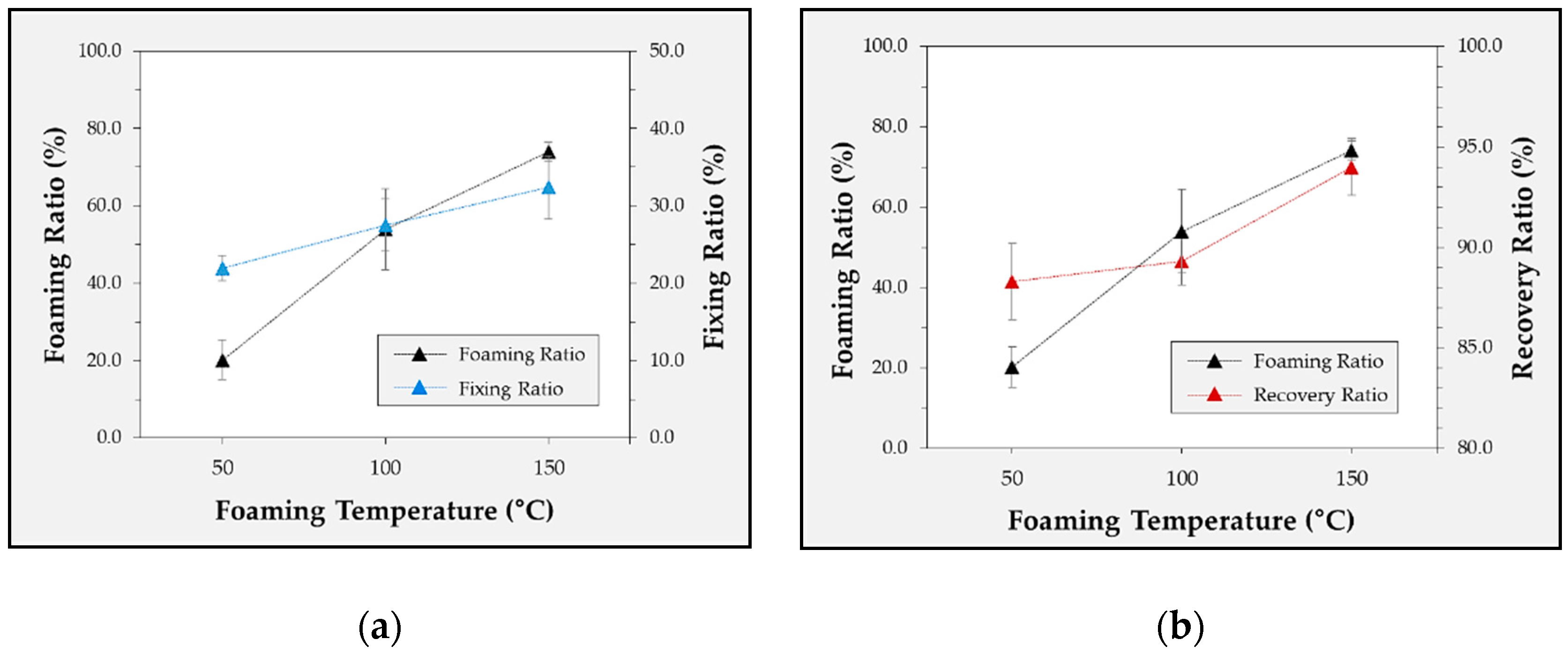1. Introduction
The objective of this study was to investigate the changes in the shape-memory-recovery characteristics of thermoplastic polyurethane (TPU), with changes in the microstructure by employing a microcellular foaming process (MCP), which is a physical foaming process [
1,
2,
3,
4]. The MCP, which is applied to TPU as a matrix, is a method for producing microsized cells having a density of >10
9 cells/cm
3 within 10 μm inside polymer plastics. This method was recently applied to the production of advanced electronic products [
5]. The plastic-manufacturing method with fine cells has several advantages, such as reduced production time, reduced product weight, reduced material cost, minimized post-transformation, insulation, and soundproofing.
In this study, a batch MCP was used. In a pressure vessel at a high temperature and high pressure, the outside of the polymer plastic was under a relatively high pressure compared with the inside. The dissolved gas was present in a single phase in the polymer, and nuclei were created in the polymer through phase changes owing to the thermodynamic instability caused by removing the pressure conditions. At this time, if heat were applied above the glass transition temperature of the polymer, the cells would grow. The matrix polyurethane consisted of two physical structures: a soft segment and a hard segment. In general, the crystalline phase within the soft-phase matrix forms a discontinuous region owing to van der Waals forces and hydrogen bonds [
6].
It is considered that by applying the MCP, it is possible to expand the area of the soft phase by increasing the distance between the crosslinking points corresponding to the crystalline phase, using the uniform fine cells formed in the polymer matrix. The soft segment plays an elastic role in deformation and recovery and is considered to have excellent recovery performance by maximizing the recovery deviation for the programmed stimulus, as it has the freedom to move. By applying an MCP, uniform cells are formed in the polymer matrix, which is not biased according to the orientation of the applied stimulus and can have uniform isotropy with regard to the recovery performance. Additionally, because the MCP has advantages such as light weight, dimensional stability, and moldability improvement, combining it with a shape-memory polymer can yield a new direction. Thus far, research on shape-memory polymers have primarily been focused on the study of shape-memory-recovery characteristics via extension polymerization and modification or the addition of fillers to side chains. There have been a few studies in which the shape-memory-recovery characteristics have been investigated by applying a physical foaming process [
7,
8,
9,
10,
11]. In this study, we attempted to optimize the shape-recovery characteristics by changing the physical properties without performing additional polymerization and reformation or incurring large costs.
In general, foamed polymer materials are lighter compared with unfoamed materials, and they have excellent thermal insulation owing to their internal fine cells. However, foamed polymer materials may exhibit lower mechanical strength than unfoamed materials [
12]. With the addition of a filler to solve this problem, the mechanical strength of the material is improved, but the shape-memory ability may be deteriorated. When the MCP is applied, good shape-memory performance, low weight, insulation, sound insulation, and dimensional stability can be realized simultaneously while minimizing the mechanical-strength degradation of the material, by forming fine and uniform cells. In the future, we expect to develop light and heat-resistant shape-memory polymers with a high shape-memory-recovery rate compared with unfoamed shape-memory polymers. Such polymers can be applied in various fields, such as smart clothing, shape-memory fibers, and hinges, and have several potential applications [
13,
14,
15,
16,
17]. For example, when applied to a shape-memory stitching thread where a knot is formed beyond a certain temperature, the mechanical strength is similar to that of a conventional unfoamed material, and the density is low; thus, the physical burden on the patient can be reduced [
18,
19,
20,
21,
22,
23,
24]. Additionally, for clothing materials that recover their shape while resting at a certain temperature, consumer convenience can be enhanced by reducing the recovery time. It is anticipated that by combining the MCP of this study with existing unfoamed shape-memory composite hinges, it will be possible to produce materials with insulation and soundproofing characteristics [
25,
26,
27,
28,
29,
30].
4. Conclusions
We investigated the shape-recovery characteristics of TPU with the MCP. Additionally, we examined the correlation between changes in the microstructure and the shape-recovery characteristics of the polymers. Experiments were performed to determine the variation in the shape-recovery ratio of the MCP for the TPU according to the foaming conditions, and the results were as follows.
CO2, N2, and He were applied as blowing gases to perform a batch process. The prepared specimens exhibited higher shape-recovery ratios than the neat specimen. The He condition yielded a 7.7% improvement in the shape-recovery ratio compared with the neat specimen. This was the lowest shape-recovery ratio among those obtained for all the experimental conditions. Under the same gas pressure, the CO2 condition yielded the highest foaming ratio, and N2 and He yielded relatively low foaming ratios. It can be considered that the highest shape-recovery ratio was obtained under a high foaming ratio. The shape-fixing ratios for all the experimental conditions were lower than that of the neat specimen. For example, the difference between the shape-fixing ratio under the 3 MPa condition with a foaming ratio of 63.9% and under the He condition with a foaming ratio of 14.8% was 1%. Therefore, we assumed that the foaming ratio had a relatively small effect on the shape-fixing ratio, compared with its effect on the shape-recovery ratio.
The foaming characteristics of TPU were affected by the gas pressure. In this case, we used CO
2 as a blowing agent because CO
2 was foamed at various pressure ranges. On the other hand, N
2 and He did not foam below 5 MPa. Therefore, we confirmed the following results when using CO
2 as the blowing agent: as the foaming ratio increased the shape-recovery ratio and shape-fixing ratio increased. The shape-recovery ratio was 8.6% higher than that of the neat specimen at 3 MPa and 19.1% higher at 5 MPa. In the case of the shape-fixing ratio, reductions of 35.6%, 28.7%, and 10.5% were observed at 3, 4, and 5 MPa, respectively, compared with the neat specimen. The foaming ratio was >60% in the range of 3–5 MPa. As shown in
Table 6, the number of cells per unit length was the largest at 5 MPa. The shape-recovery ratio and shape-fixing ratio improved as the number of cells increased, according to the pressure condition. Thus, it is considered that the number of cells affects the improvement in the shape-recovery ratio and shape-fixing ratio of TPU.
Experiments were performed in which foaming temperatures of 50, 100, and 150 °C at 5 MPa were used; this yielded the best shape-memory-recovery characteristics among the gas-pressure conditions. Additionally, CO2 was used as a blowing agent, which had the best shape-memory-recovery characteristics among the gas species. In the case of the shape-fixing ratio, reductions of 36.5%, 24%, and 10.5% were achieved at 50, 100, and 150 °C, respectively. In the case of the shape-recovery rate, improvements of 9%, 13.2%, and 19.1% were observed at 50, 100, and 150 °C, respectively. By varying the foaming temperature, it was confirmed that for the same gas pressure, the foaming ratio varied with the amount of gas dissolved in the polymer. The shape-memory-recovery characteristics also appeared to be affected by the foaming ratio of the TPU, which varied with the foaming temperature. The maximum number of cells was observed at 150 °C, and the shape-recovery ratio changed with changes in the cell density due to cell nucleation.
In studies about polymer foams, epoxy-based foams were used, and nanometer sized additives were added along with the polymer foams. These studies were done to investigate the change of shape-memory-recovery characteristics according to foam formation and additive contents. It was found that the shape-memory-recovery properties of the polymer composites decreased as the additives content increased. However, we investigated the relationship between microstructures and shape-memory-recovery characteristics. MCPs were applied to change the microstructure of TPU, and it was confirmed that the generated cell size was set smaller than that of the conventional foaming process by chemical synthesis. MCPs, physical foaming processes, and the use of an inert gas were different from the conventional chemical foaming, and as the cell distribution increased, the shape recovery characteristics were improved.













